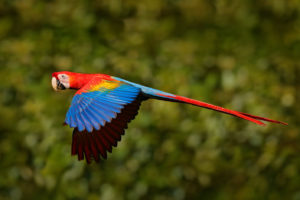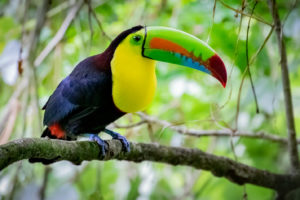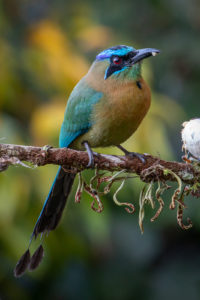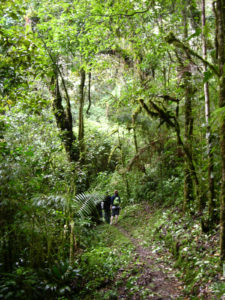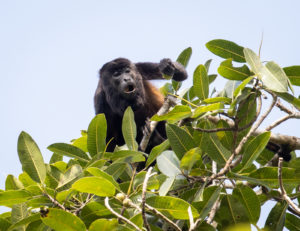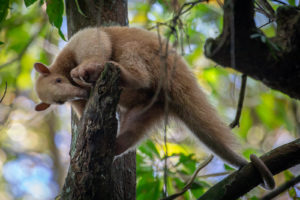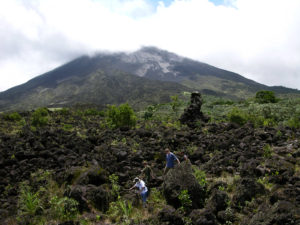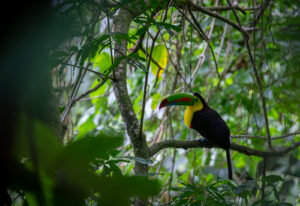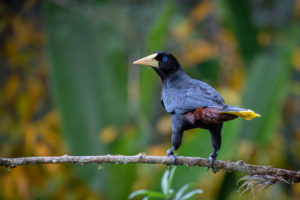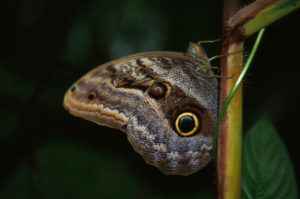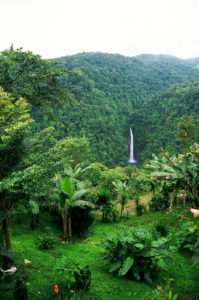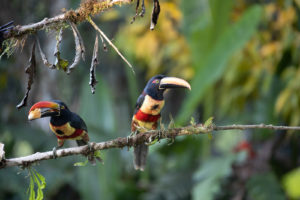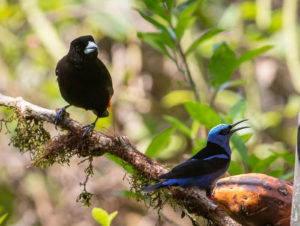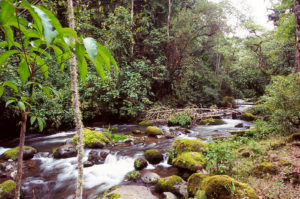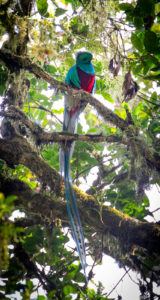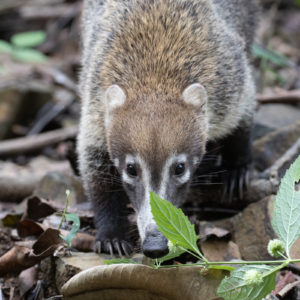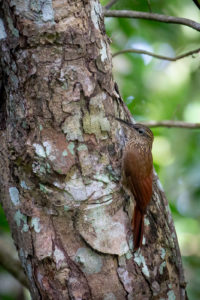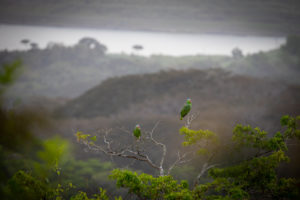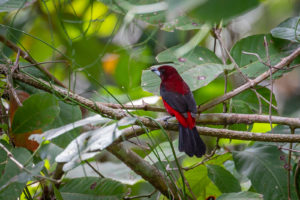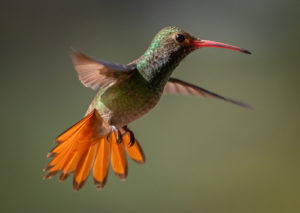Birding Costa Rica
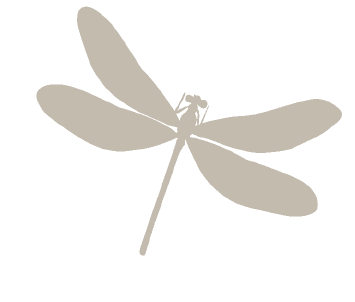
October 31 to November 10 2022
$3,750 | ($500 deposit due upon registration)
Single Supplement: $635
12 participants max
C
osta Rica offers both a wonderful introduction to tropical birding and a destination to return to again and again. Twice the size of Vermont, the country has over 800 bird species, including 50 species of hummingbird alone. In addition to all the tanagers, parrots, and raptors, there are sloths, monkeys, orchids and beautiful butterflies to enjoy. Our group will visit a wide variety of tropical habitats in search of Scarlet Macaw, Resplendent Quetzal, Ocellated Antbird and so much more. Comfortable lodging in beautiful, birdy environments will make for an unforgettable experience.
Additional Information
Flow of the Day: The itinerary is designed to maximize our experience with Costa Rica’s great diversity of birdlife and ecosystems. We won’t, however, be rushing from place to place to chase the largest species list possible. Our goal is to spend time appreciating the species we encounter at an enjoyable pace. Birding walks begin in the early morning, and we travel slowly to allow for the best bird and wildlife encounters and observation.
Afternoon plans may allow for some rest time at the lodges, though this is not always feasible when we are transferring between lodges or birding far from the lodge on a given day.
Clothing: Pack light field clothing of neutral colors. Bring several pairs of long pants and comfortable, light, airy shirts. Long-sleeved (relaxed fit) shirts are useful for protection from the sun, as is a light hat or cap. Be sure to have a pair of comfortable walking shoes or hiking boots, plus a second pair of tennis shoes or sandals. A fleece, a hat, and gloves are important for our visit to higher elevation areas where it can be quite chilly.
Equipment: Bring a pair of binoculars, a field guide and a camera with extra batteries. Your guide will carry spotting scopes. Pack sunglasses and sunscreen, a small flashlight or headlamp, a small alarm clock (a smartphone will work), insect repellent, a small daypack, and a small folding stool if you get tired standing for long periods waiting for birds.
Physical Expectations: Much of the birding on this trip will be along roadsides or easily walked trails, but do expect some hilly and uneven conditions. Participants should be able to hike on moderate terrain up to 3 miles per day, and be ready to expect conditions that may be hot, cold, dry, wet, or anything in-between.
Transportation: We will be traveling in a small bus. Trip capacity is limited for traveling comfortably in our vehicle.
Accommodations: All of the lodges where we’ll be staying are situated in or near ecological reserves. They are chosen for strategic access to great birding, rather than for the bells and whistles that come with more luxury resorts. That said, all lodges are clean and comfortable, and often allow for excellent birding right at the hotel property.
Meals: We'll have a hot meal each night for dinner at the lodge or in town. Breakfasts and lunches will be a combination of sit-down meals and picnics, depending on where we are. Like our accommodations, our dining arrangements are selected to have filling, tasty meals without spending our peak birding times sitting inside restaurants.
Chip Darmstadt, former executive director of North Branch Nature Center, is an avid neotropical birder and naturalist. Chip has guided birding trips around the US and around the world for nearly 25 years, observing over 2,000 bird species along the way. After first working as a field biologist in Monteverde, Costa Rica back in 1990, Chip has had the pleasure of bringing dozens of nature lovers to the country.
Leo Garrigues, our local guide for the trip, is a top-notch Costa Rican birder and guide. Leo has a gift for finding the skulkiest of antbirds and sharing his passion for his country’s birds. A birder since the age of six, Leo has been guiding birding and natural history tours for many years. Richard Garrigues, Leo’s father, is the author of The Birds of Costa Rica, the must-have field guide for the country.
What’s included:
- All lodging and meals.
- All ground transportation throughout the trip.
- Expert naturalist guides.
- Any entrance fees and park admissions.
- Use of high-quality shared spotting scopes.
- Pre-departure orientation session before the trip.
What is not included:
- Airfare and transportation to arrival hotel.
- Travel insurance
- Lodging and meals beyond the above-mentioned dates
- Gratuities.
- Pre-trip expenses.
- Alcoholic beverages.
- Incidentals and extras in hotels/lodges.
Ready to go to Costa Rica?
Email [email protected] to get signed up.
Considering the current (and future) reality of international travel and COVID, it’s safe to say that there will be a heightened level of risk and uncertainty involved in international travel for the foreseeable future.
North Branch Nature Center feels a responsibility to use ecotourism, as it has for the last 20 years, to support biodiversity conservation and the struggling, critical local businesses that steward imperiled animals and habitats.
NBNC and our Costa Rica partners are confident in the safety of this excursion. That said, decisions around acceptable risk vary greatly from individual to individual. Our goal as trip leaders is to make sure that we can communicate all the known and unknown variables as clearly and transparently as possible, so that you can make an informed decision about whether this trip is right for you.
Please read the following considerations carefully. If you're ready to reserve your space on this trip, let us know!
- Our group will be masked when indoors, but we cannot guarantee the behavior of others, nor predict what local mask requirements will be.
- As of January 2022, vaccination rates for the country of Costa Rica are roughly 70-80%.
- We will dine outdoors when possible, but this is weather and location dependent. We may eat indoors in restaurants with some regularity.
- Last-minute changes to the itinerary may be required depending on the COVID testing requirements for international travel at the time of our trip.
- If someone gets sick during the trip, they will need to isolate in a guest house at their own expense.
- If there is a CDC Do Not Travel advisory at the time of the trip, we will not go. If there is no travel advisory, and if our partners feel it is safe for us to go, and there is no travel ban, we will go
- As a result of unpredictable travel bans in the US and any connecting countries, there will be a higher likelihood of dropped connections and cancelled flights on both ends of our trip that may cause significant disruption. While we can provide flight recommendations, the flights are your responsibility as the traveler. Neither NBNC nor our partners will be able to support you until you arrive in-country.
- Trip cancellation may happen on short notice for the reasons listed above or otherwise.
- Travel insurance will be your primary protection against expenses incurred due to trip interruptions, airline fiascos, cancellation, etc. Travel insurance is typically very effective for recouping all travel expenses and trip fees in the event of cancellations.
Here is an eBird list of all species seen in Costa Rica in November since 2019. The frequency bar charts will help give you an idea of how regularly each species is seen.
Itinerary
Day 1 – Arrive in Costa Rica
Welcome dinner and overnight at the Hotel Bougainvillea. (Please note that depending on the time of day and traffic conditions, a taxi from the airport to the hotel can take anywhere from 30 minutes to over an hour.)
Day 2 – Day trip to Irazú Volcano
We’ll be at an altitude of nearly 11,000 feet, so be prepared for cool weather. This will be our only chance for a number of high elevation specialties such as Fiery-throated Hummingbird, Volcano Hummingbird, Black-capped Flycatcher, Timberline Wren, Black-billed Nightingale-Thrush, Sooty Thrush, Long-tailed Silky-Flycatcher, Sooty-capped Chlorospingus, Volcano Junco, Large-footed Finch, Flame-throated Warbler, and Slaty Flowerpiercer—all endemic to the highlands of Costa Rica and adjacent western Panama.
With some luck, we might also get views of Buffy-crowned Wood-Partridge, Spot-crowned Woodcreeper, Rufous-browed Peppershrike, Lesser Goldfinch, Wrenthrush, Flame-colored Tanager, and possibly even the amazing Resplendent Quetzal! Overnight at Hotel Bougainvillea.
Day 3 – Arenal Volcano
Today we will journey to the foothills of this active volcano, stopping along the way for some mid-elevation birding and the possibility of such species as Buff-fronted Quail-Dove, Prong-billed Barbet, Northern Emerald-Toucanet, Red-faced Spinetail, Gray-breasted Wood-Wren, Golden-browed Chlorophonia, Common Chlorospingus, Chestnut-capped Brushfinch, Slate-throated Redstart, Spangle-cheeked Tanager, and Silver-throated Tanager.
Keeping an eye on hummingbird feeders should also produce looks at Green Thorntail, Green-crowned Brilliant, White-bellied Mountain-gem, Violet Sabrewing, Coppery-headed Emerald, and Black-bellied Hummingbird, among others. Overnight at Arenal Observatory Lodge.
Day 4 – Arenal Birding
There’s a high probability that you may awaken to the sound of Mantled Howler Monkeys and Crested Guans, which is a good thing, since you won’t want to miss a minute of the pre-breakfast birding on the hotel grounds. Though some 2,000 feet above sea level, the lodge has a definite tropical feel, which will be all the more obvious when we start seeing the likes of Gartered Trogon, Collared Aracari, Yellow-throated Toucan, Keel-billed Toucan, White-crowned Parrot, Common Tody-Flycatcher, Band-backed Wren, Montezuma Oropendola, Black-cowled Oriole, and Tropical Parula. Finding a fruiting fig tree can be a spectacle with a seemingly endless parade of species coming and going that might include White-throated Thrush, Hepatic Tanager, Crimson-collared Tanager, Golden-hooded Tanager, Bay-headed Tanager, Emerald Tanager, Scarlet-thighed Dacnis, Green Honeycreeper, and Buff-throated Saltator.
And while the lodge does not have hummingbird feeders, there are numerous flowering shrubs that attract an impressive variety of hummers, such as White-necked Jacobin, Green Hermit, Stripe-throated Hermit, Brown Violetear, Purple-crowned Fairy, Black-crested Coquette, Violet-headed Hummingbird, Bronze-tailed Plumeleteer, Crowned Woodnymph, Scaly-breasted Hummingbird, Blue-vented Hummingbird, and Blue-throated Goldentail.
At some point during the day, we’ll do some forest birding that could turn up Dusky, Bicolored, Spotted, and Ocellated Antbirds—especially if we’re fortunate enough to cross paths with marauding army ants. Other species that could conceivably join the fray include Thicket Antpitta, Spotted Woodcreeper, Bright-rumped Attila, Brown Jay, Nightingale Wren, Black-headed Nightingale-Thrush, and Buff-rumped Warbler.
An extra bonus at this time of year is the possibility of finding Three-wattled Bellbird in the area! Overnight at Arenal Observatory Lodge.
Day 5 – Caño Negro Wildlife Refuge
We’ll have another morning to enjoy birding in this fantastic setting before packing up and traveling towards the northern border and the Caño Negro wetlands.
Roadside birding en route to the village of Caño Negro often yields views of birds such as Plain-breasted Ground Dove, Striped Cuckoo, Green-breasted Mango, White-throated Crake, Bare-throated Tiger-Heron, Lesser Yellow-headed Vulture, Laughing Falcon, Ruddy-breasted Seedeater, Thick-billed Seed-Finch, and Nicaraguan Seed-Finch. While the grounds of the lodge itself hold two area specialties: Gray-headed Dove and Spot-breasted Wren.
In the afternoon, we’ll do a boat ride in the Caño Negro Wildlife Refuge to enjoy the sheer spectacle of waterbirds typically present. We’ll also hope to see Russet-naped Wood-Rail, Sungrebe, Limpkin, Boat-billed Heron, Glossy Ibis, Green Ibis, Black-collared Hawk, Olive-throated Parakeet, Canebrake Wren, Nicaraguan Grackle, Prothonotary Warbler, and perhaps even Jabiru. Overnight at the Hotel de Campo.
Day 6 – Volcano Foothills and Caño Negro
Before breakfast, we’ll venture out on the waterways once again in search of anything we’ve missed so far, as well as hopefully even better views of some of the species we’ve already seen. At this time of year, all six species of New World kingfisher can be found in Caño Negro, from the diminutive American Pygmy Kingfisher to the hefty Ringed Kingfisher.
Eventually, we’ll board the bus for the relatively short journey back up into the foothills, this time staying at the base of Tenorio Volcano. Overnight at Celeste Mountain Lodge.
Day 7 – Celeste Mountain Tropical Forest Birding
By now, we should have made the acquaintance of most of the species found in the hotel garden, however, it’s worth keeping an eye on the hanging heliconia blossoms should a White-tipped Sicklebill decide to make an appearance. Finding the majority of our target species in this region, though, will involve doing some trail walking in the forests, where we’ll be attentive to sounds that will alert us to the presence of birds such as Black-eared Wood-Quail, Purplish-backed Quail-Dove, Black-throated Trogon, Tody Motmot, Yellow-eared Toucanet, Cinnamon Woodpecker, Brown-hooded Parrot, Streak-crowned Antvireo, Dull-mantled Antbird, Northern Schiffornis, Scale-crested Pygmy-Tyrant, Song Wren, Golden-crowned Warbler, and Carmiol’s Tanager. Outside of the forest, scanning the skies might result in views of White Hawk or Ornate Hawk-Eagle. Overnight at Celeste Mountain Lodge.
Day 8 – Pacific Lowlands Part I
We’ll have a final morning to look for anything that may have eluded us thus far, or perhaps just enjoy the antics of a colony of Chestnut-headed Oropendolas at a nest tree.
After lunch, we’ll cross the low pass between Tenorio and Miravalles Volcanoes and descend to the northern Pacific lowlands. This seasonally dry part of country should still look fairly green as the rainy season will just be coming to an end; however, in another four months it will look entirely different as the pastures will be parched and brown, and many of the trees will have dropped their leaves in an effort to conserve precious moisture. This dry forest habitat reaches its southern limit near the area of our next destination: Carara National Park. Some of the species that we’ll hope to see in this habitat include Crested Bobwhite, Common Ground Dove, Lesser Ground-Cuckoo, Cinnamon Hummingbird, Ferruginous Pygmy-Owl, Black-headed Trogon, Turquoise-browed Motmot, Yellow-naped Parrot, Long-tailed Manakin, White-throated Magpie-Jay, White-lored Gnatcatcher, Stripe-headed Sparrow, Streak-backed Oriole, and Blue Grosbeak. Overnight at Hotel Villa Lapas.
Day 9 – Pacific Lowlands Part II
Some pre-breakfast birding on the hotel grounds will offer an introduction to the birds of the Pacific lowland wet forest habitat. Possibilities include Marbled Wood-Quail, Costa Rican Swift, Charming Hummingbird, Fiery-billed Aracari, and Riverside Wren, to name a few.
We’ll spend the rest of the morning in Carara National Park with chances to find such neotropical goodies as White-whiskered Puffbird, Rufous-tailed Jacamar, Streak-chested Antpitta, Black-faced Antthrush, Royal Flycatcher, and, the true headliner, Scarlet Macaw. Orange-collared, Red-capped, and Blue-crowned Manakins occur here, too.
In the afternoon, we’ll take a boat ride on the Tarcoles River, where, in addition to seeing lots of shorebirds and waders, we’ll search for some species found only in mangroves: Rufous-necked Wood-Rail, Panama Flycatcher, Mangrove Vireo, the mangrove race of Yellow Warbler, and the endemic Mangrove Hummingbird. Overnight at Hotel Villa Lapas.
Day 10 – Pacific Lowlands to the Central Valley
We’ll have the entire morning to continue our exploration of the Carara area before returning to the Central Valley in the afternoon. Overnight at Hotel Buena Vista.
Day 11 – Departures
Transfer to the international airport for your departing flight.
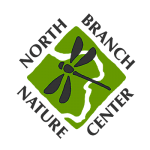
713 Elm Street
Montpelier, Vermont 05602
(802) 229-6206
Hours: Center Open Monday-Friday 9-4
Trails Open 24/7

